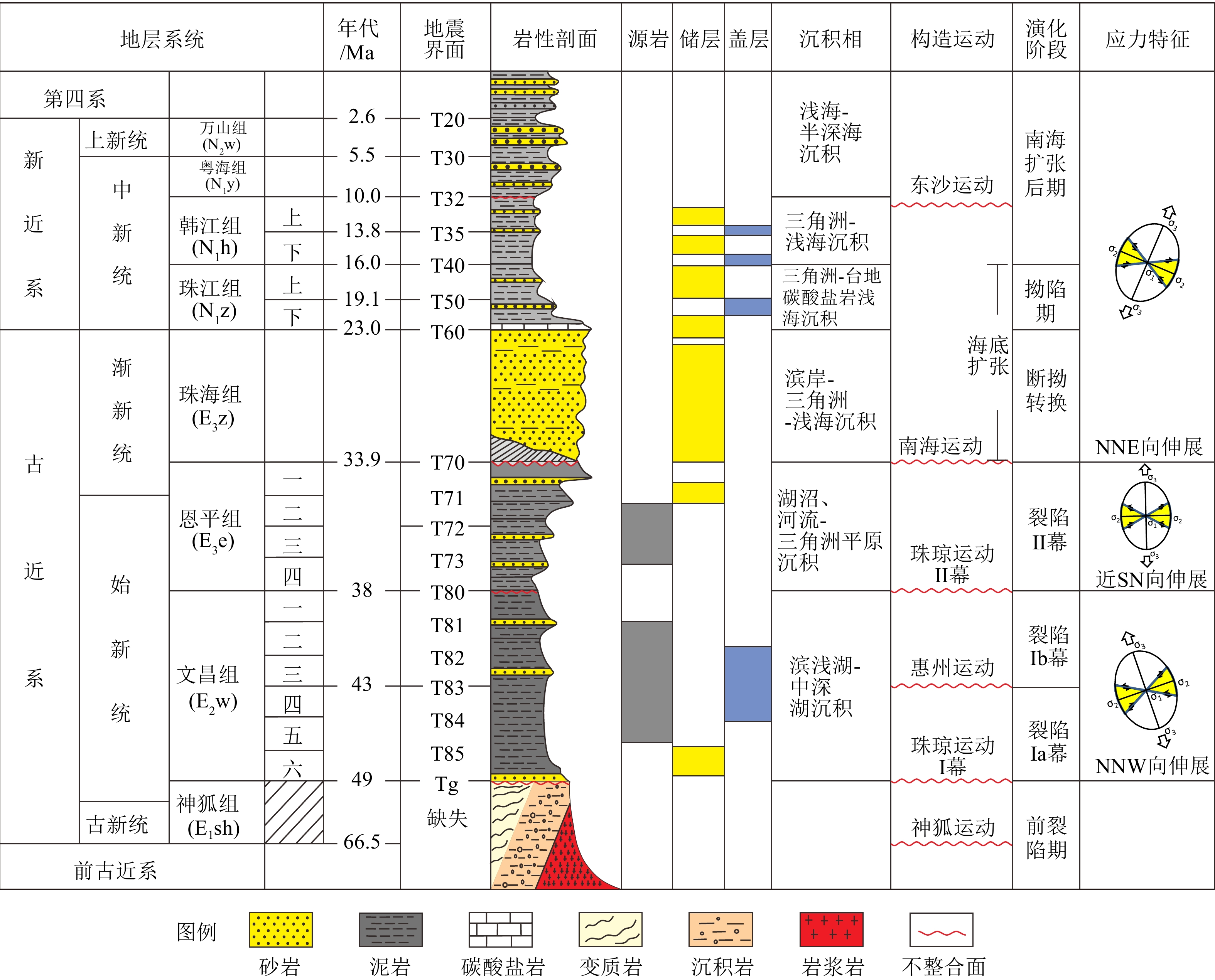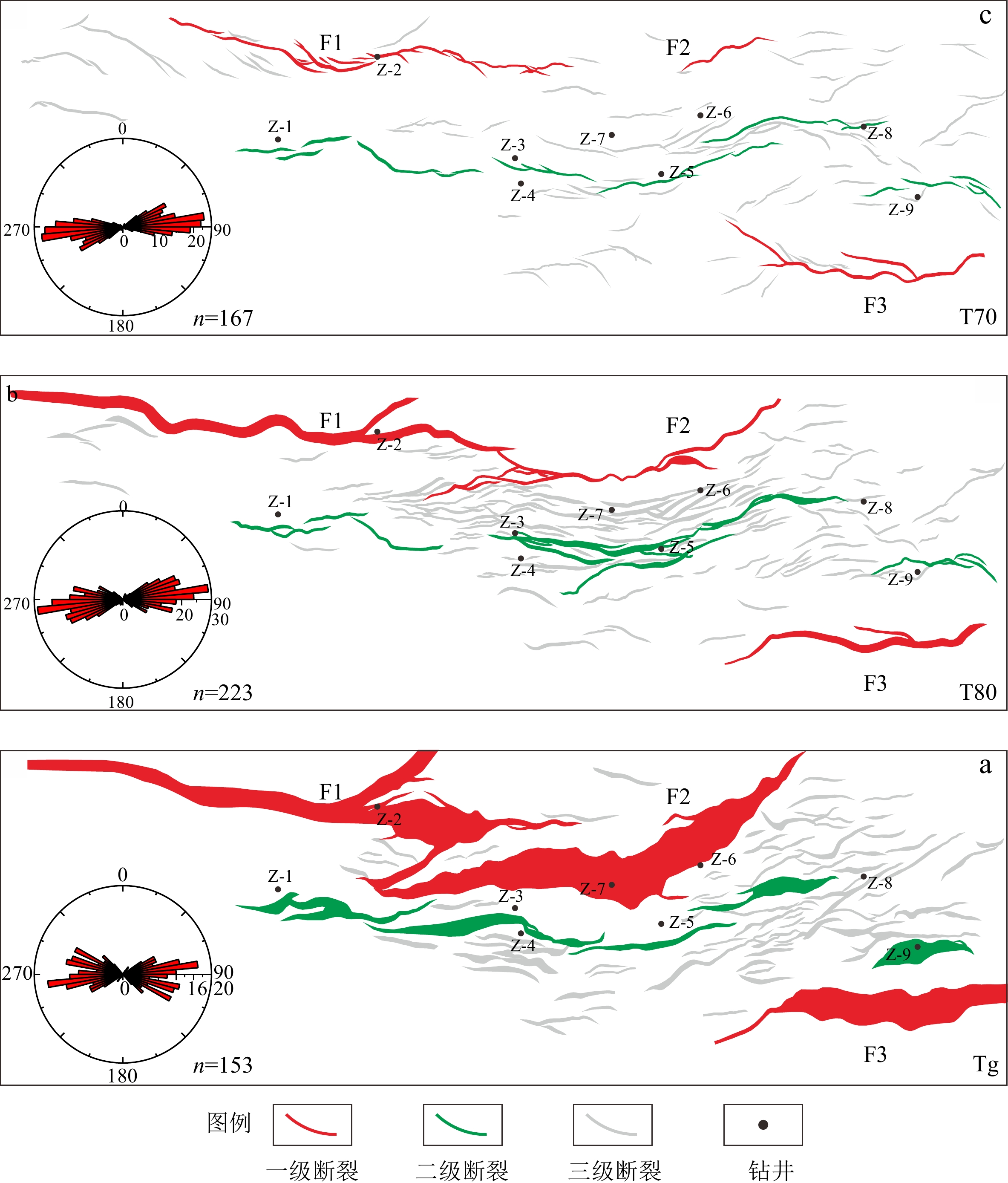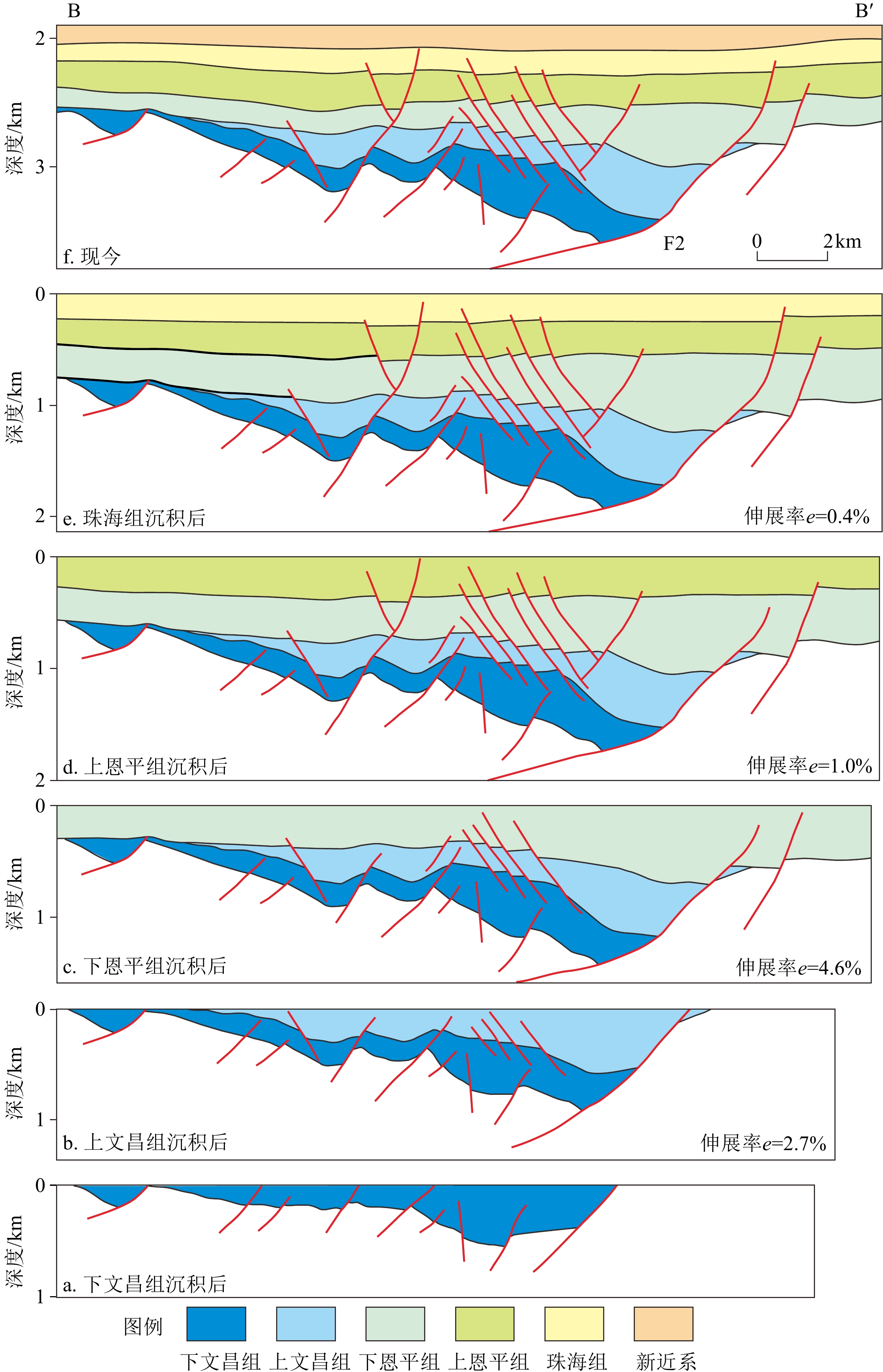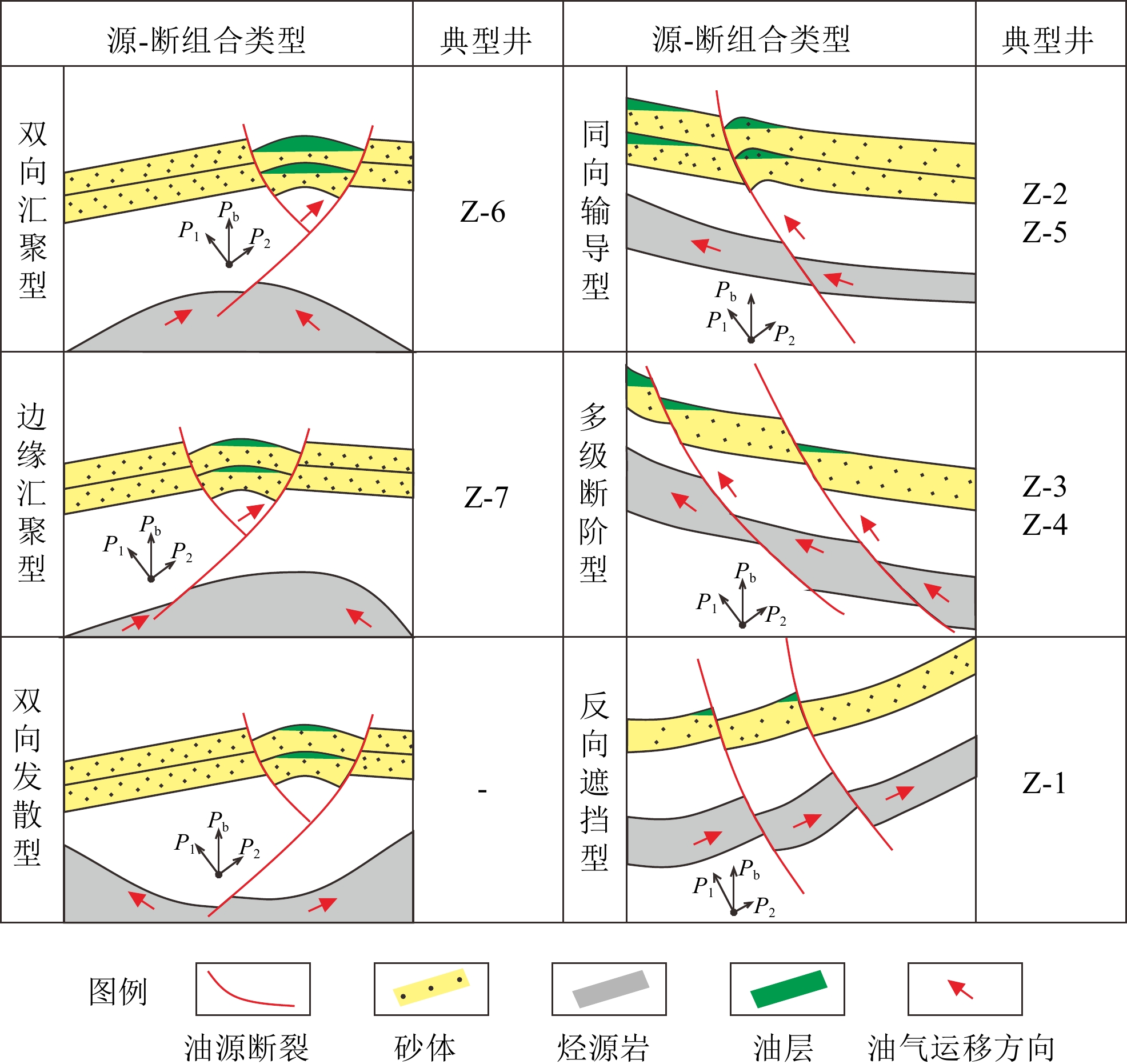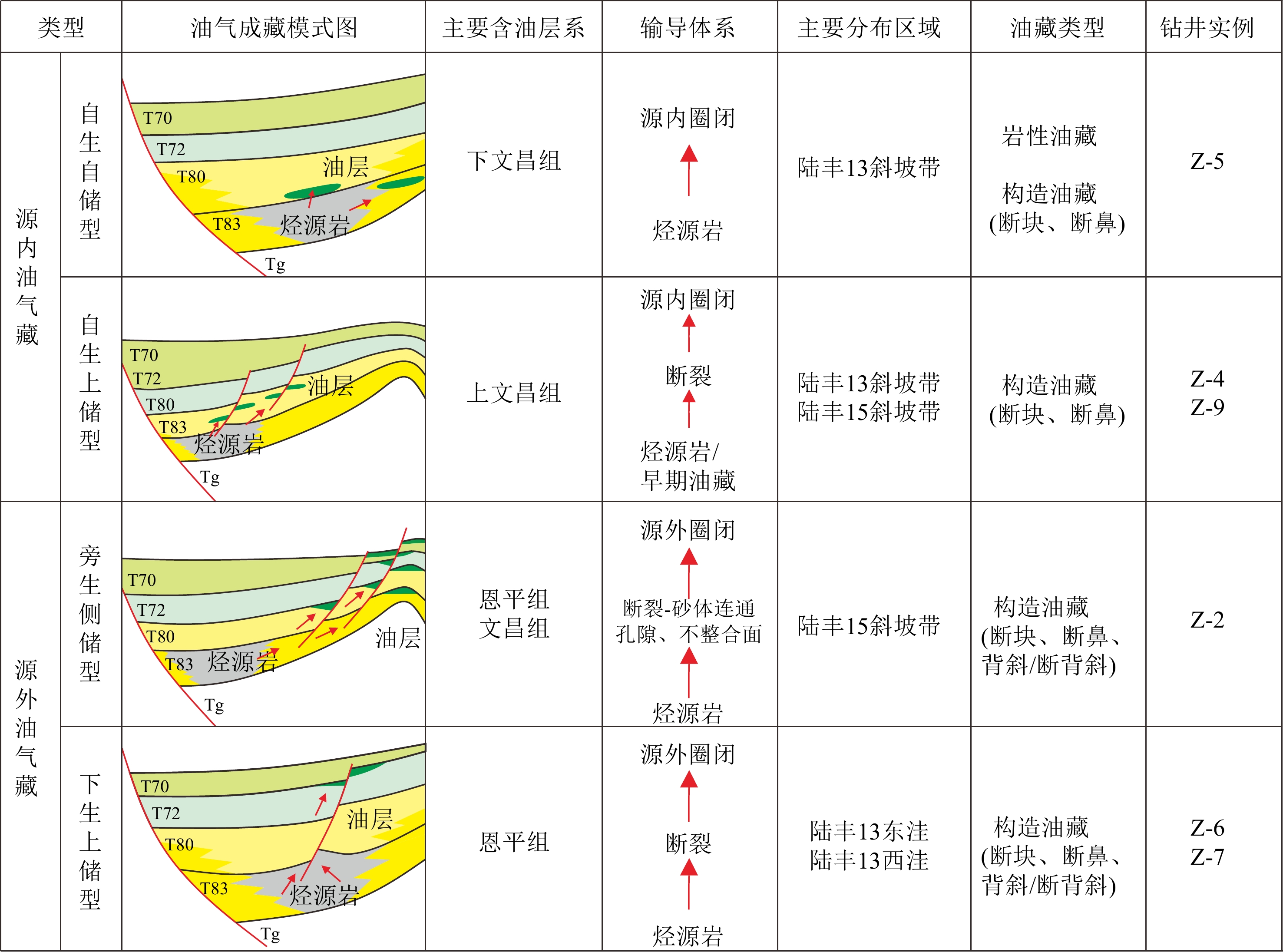Fault characteristics and hydrocarbon accumulation in the southern Lufeng Sag, Pearl River Mouth Basin
-
摘要: 陆丰凹陷是位于珠江口盆地珠I坳陷内的富烃凹陷,凹陷南部地区古近系具有良好勘探潜力。以三维地震资料解释成果和钻井资料为基础,分析陆丰凹陷南部地区断裂发育特征及演化过程,明确断裂对油气运聚成藏的控制作用,划分油气成藏组合类型。陆丰凹陷南部发育3个半地堑结构的洼陷,分别受活动性较强的3条铲式边界断裂控制。断裂主要发育于古近纪,斜坡带部位发育密度大,平面优势走向由深层NEE向至浅层近S-N向偏转,断裂密集带自东向西迁移。断裂可分为三级,分别控制洼陷结构、局部构造带和构造圈闭的形成。依据活动期次可划分出文昌期活动断层、恩平期活动断层和文昌-恩平期活动断层。陆丰凹陷南部地区断裂控制着断鼻、断块及断背斜圈闭的形成,断裂与烃源岩的组合类型差异影响着油气运聚效率。综合油气富集层系、输导方式、断裂活动性及源-断组合类型等成藏要素,建立源内自生自储型、源内自生上储型、源外旁生侧储型和源外下生上储型等4类油气成藏组合类型,对下一步油气勘探实践具有理论指导意义。Abstract: The Lufeng Sag is a hydrocarbon-rich sag located in Zhu I depression of the Pearl River Mouth Basin, and the Paleocene in the southern sag has good exploration potential. Based on the 3D seismic data interpretation and drilling data, we analyzed the characteristics of fault deformation and evolution in the southern Lufeng Sag, and the controls of faults on hydrocarbon transport and accumulation. In addition, the types of hydrocarbon combinations were classified. Three half-grabens in the southern Lufeng Sag were controlled by three listric boundary faults with strong activity. The faults were mainly developed during the Paleogene. The distribution density of faults is the highest in the slope zones, and the dominant trends changes from NEE to nearly SN upwards. Also, the dense zone of faults migrates from east to west. The faults can be divided into hierarchical classes 1 to 3, Class 1 the formation of sags, Class 2 determines local structural belts, and Class 3 restrains structural traps. The faults in the southern Lufeng Sag were active during the deposition periods of the Wenchang Formation, the Enping Formation, and the Wenchang-Enping Formations. The faults control the formation of fault noses, fault blocks, and fault anticlinal traps, and the difference in combination models of faults and source rocks affects the efficiency of hydrocarbon migration and accumulation. Based on the hydrocarbon accumulation factors such as enrichment strata, transportation models, fault activity, and source-faults combination types, four hydrocarbon accumulation models were established: in-source autogenous self-storage, in-source autogenous up-storage, out-source side-storage and out-source down-storage This study provided a theoretical support for further oil and gas exploration in the southern Lufeng Sag.
-
Keywords:
- fault /
- trap /
- source rock-fault assemblage /
- hydrocarbon accumulation /
- Paleogene /
- southern Lufeng Sag
-
断裂是含油气盆地的重要研究对象,控制着盆地结构与演化过程,同时与圈闭的形成、分布以及油气运聚过程等关键成藏要素密切相关[1-7]。而油气成藏模式是对油气藏特征、形成过程等多要素的总结,综合各主控因素建立动态成藏过程,对有利目标勘探具有重要指导意义[8-9]。
陆丰凹陷是珠江口盆地珠I坳陷内的一个富油凹陷,近年来在陆丰凹陷南部地区取得多个重要油气勘探突破[10-12]。前人对陆丰凹陷的构造演化、沉积充填及油气成藏等方面均开展过详细研究,并取得一定成果[13-18]。随着勘探的深入及新油田的不断发现,研究区的基础资料逐渐丰富,但仍存在较多问题,如断裂输导能力的强弱、油气运移路径及运聚效率等因素尚不明确,从而导致油气成藏要素相似、构造位置相邻的钻井勘探成效经常存在较大差别[10, 15]。因此需要对已有的成果认识不断总结完善,对油气成藏的控制因素也需要进一步深化。本文在充分吸收前人研究成果的基础上,以断裂和油气成藏为两个主要研究目标,结合陆丰凹陷南部的最新三维地震解释成果及钻井资料,对陆丰凹陷南部的断裂开展几何学及运动学研究,明确断裂发育特征及其演化过程,并探究断裂对油气运聚成藏的控制作用,总结油气成藏模式,为该地区油气勘探提供理论依据。
1. 区域地质概况
珠江口盆地位于南海北部陆缘,整体发育NE向展布的坳隆相间结构,自北向南包括北部隆起带、北部坳陷带、中央隆起带、南部坳陷带和南部隆起带(图1a)。陆丰凹陷位于珠江口盆地北部坳陷带的珠I坳陷内,南至东沙隆起,北至北部隆起,西接惠陆低凸起,东接海丰凸起。陆丰凹陷内发育多个次级洼陷,其中南部地区发育陆丰13西洼、陆丰13东洼和陆丰15洼(图1b)。
陆丰凹陷在新生代经历了多期构造演化,始新世为裂陷演化阶段,主要沉积文昌组和恩平组,各洼陷在该时期也基本形成;渐新世—新近纪转变为拗陷演化阶段,构造活动微弱,沉积了珠海组、珠江组、韩江组、粤海组和万山组,沉积环境也随之由陆相转变为海相(图2)。珠琼运动I幕使陆丰凹陷遭受强烈伸展作用,南部地区的控洼断裂发生强烈活动,形成了欠补偿的沉积环境,洼陷内快速沉积较厚的半深湖-深湖相暗色泥岩,成为该地区的主力烃源岩[13, 19-20],其中,文昌组烃源岩TOC约为0.6%~7.7%,R0值为0.7%~1.2%,生烃潜力较好[10, 21-22]。陆丰凹陷油气大规模成藏期为新近系韩江组沉积期[11, 19]。
2. 断裂发育特征
2.1 剖面变形特征
依据断裂规模、活动强度及对沉积的控制作用等,可将陆丰凹陷南部地区的断裂划分为3个级别。一级断裂为控洼边界断裂,活动性强,主要包括陆丰13西断层、陆丰13东断层和陆丰15断层(分别对应图1中的F1、F2和F3);二级断裂活动性弱于一级断裂,主要控制洼陷内局部构造带的形成演化;三级断裂数量多分布广,多为单期活动且活动性较弱,其形成演化受控于一级或二级断裂。
陆丰13西断层(F1)为近铲式形态的南倾正断层,断层向下断穿至基底,向上终止于韩江组(图3a)。陆丰13西断层在古近纪持续活动,使陆丰13西洼呈北断南超的楔形结构。断裂在新近纪发生微弱活动,并不再控制洼陷结构特征。陆丰13西洼的生长地层厚度由下文昌组向上至恩平组逐渐增厚,反映了由裂陷I幕至裂陷II幕,陆丰13西断层的活动性逐渐增强。洼陷内三级断裂发育较少,以南倾板式正断层为主,多分布于文昌组内,以多米诺式断层组合富集于陆丰13斜坡带。
陆丰13东断层(F2)为近铲式形态的低倾角南倾正断层,断层向下断穿至基底,向上终止于珠江组内(图3b)。陆丰13东断层在文昌组沉积期强烈活动,控制着洼陷北断南超半地堑的形成,至恩平组沉积期断层活动性逐渐减弱,断层两盘地层厚度差异明显减小(图3b)。陆丰13东洼内三级断裂发育较多,在陆丰13斜坡带发育断穿基底的南倾板式正断层,主要富集于文昌组内;在陆丰13东洼内则发育南倾或北倾正断层,构成似花状组合样式,主要富集于恩平组内(图3b)。陆丰13东洼及陆丰13斜坡带内的三级断裂形成时间存在差异,其中陆丰13斜坡带的板式正断层形成于文昌组沉积期,而洼陷内的似花状正断层组则集中形成于恩平组沉积期。
陆丰15断层(F3)位于凹陷南侧,断层下盘为东沙隆起,是一条近铲式形态的大型北倾正断层(图3c)。断层纵向断穿层位最多,向下断穿至基底,向上终止于万山组内。陆丰15断层在古近纪强烈活动,使陆丰15洼呈南断北超的半地堑结构。生长地层厚度变化表明断层在下文昌组沉积期活动性最强,随后逐渐减弱。三级断裂集中发育于陆丰15斜坡带,以断穿基底的南倾板式或铲式正断层为主,形成于文昌组沉积期,部分断层在恩平组沉积期继续活动,与新形成的断层构成“Y”型组合样式(图3c)。
2.2 平面展布特征
陆丰凹陷南部主要发育NNE、NWW两组基底断裂[23-24],部分基底断裂在古近纪再活化,走向与基底断裂基本一致,因此断裂在Tg反射层上以NEE、NWW为主(图4a)。在Tg反射层,一级断裂延伸距离远,水平断距大,走向以NWW-EW为主,其中陆丰13东断层的东段为NE走向。三级断裂主要分布于陆丰13东洼和陆丰15洼的斜坡带处,断裂平面延伸短,水平断距小,与一级断裂的走向基本一致。裂陷I幕为NNW向伸展(图2),在凹陷内形成较多三级断裂,T80反射层的断裂优势走向变为NNE向(图4b)。此外,Tg-T80反射层的断裂密集带也由陆丰15斜坡带迁移至陆丰13东断层南部的斜坡带(图4b)。裂陷II幕转为近S-N向伸展(图2),T70反射层的断裂优势走向变为近EW向(图4c)。断裂平面延伸距离较长,但水平断距小,且在该反射层未见明显的断裂密集带,而是在凹陷各处零散分布(图4c)。
3. 断裂活动期次与演化
陆丰凹陷南部地区的断裂主要在古近纪发生活动,但不同断裂的活动期次及强度存在一定差异。断裂生长指数广泛应用于对断裂活动期次及活动强度的判别[25-27]。以位于研究区中部的地震剖面为例进行断裂生长指数分析,其中断层f1-f5在文昌组沉积期活动,生长指数大于1。断层f1、f2和f5断穿基底且在文四段活动强度较大;断层f3的活动强度由下文昌至上文昌组沉积期逐渐增大;断层f6在恩平组沉积期形成并活动。断层F2和f7分别为控洼边层和与之对倾的反向调节断层,在文昌-恩平组沉积期持续活动且活动强度较大(图5)。
整体来看,陆丰凹陷南部地区断裂的活动时期与凹陷整体演化阶段基本一致,在裂陷I幕和裂陷II幕均有断裂发生强烈活动。依据断裂活动期次及强度,可将发育于古近纪的断裂划分为3类:文昌期活动断层、恩平期活动断层和文昌-恩平期活动断层。其中文昌期活动断层在文昌组沉积期开始形成并强烈活动,部分向上断穿至恩平组内,但在恩平期一般都活动较弱,属于继承性活动(如f1-f5)。恩平期活动断层可能向下断穿至文昌组内,但在文昌期不活动(如f6)。文昌-恩平期活动断层则是在文昌组和恩平组沉积期均发生强烈活动,控制了洼陷或构造带的结构特征(如f7、F1-F3)。从断裂级别及其活动性来看,一级断层和二级断层主要对应文昌-恩平期活动断层,而三级断层则对应文昌期或恩平期活动断层。
综合区域构造运动及应力场特征,在凹陷构造演化的基础上进一步分析断裂形成演化过程(图6)。受太平洋板块俯冲作用影响,陆丰凹陷南部在裂陷I幕处于NW-SE方向的伸展环境[23-24],部分NEE、NWW走向基底先存断裂活化,促使文昌期活动断层开始形成,平面走向以NEE和NWW向为主。控洼断层(一级断层)和控带断层(二级断层)在这一时期的活动性逐渐增强,控制各洼陷或构造带的结构特征(图6a-b)。在裂陷II幕,受太平洋板块俯冲后撤和古南海拖曳作用影响,区域伸展方向由NW-SE向转为近S-N向[23-24],陆丰凹陷发生张扭变形,部分文昌期活动断层发生继承性活动,但活动强度较小。恩平期活动断层在该时期形成,受扭动作用的影响,断层在剖面上呈“Y”型、似花状等组合样式(图6c),在平面上以近E-W走向为主。控洼断层和控带断层在裂陷II幕持续活动,控制洼陷/构造带恩平组的结构特征。
后裂陷期分为断拗转换期和拗陷期,断裂逐渐停止活动(图6e-f)。珠海组沉积期,珠江口盆地由陆相变为海相沉积环境,陆丰凹陷南部进入断拗转换阶段。该时期未见新生断层发育,但部分恩平期活动断层可继承性微弱活动(图6e)。拗陷期(珠江组沉积期—现今),陆丰凹陷南部的断裂活动基本停止,极少量断层(如陆丰15断层)在东沙运动时期(韩江组沉积期)发生弱活动(图3c)。拗陷期地层表现为厚层披覆沉积,基本不发生构造变形(图6f)。
4. 断裂对油气成藏控制作用
4.1 断裂与圈闭类型
勘探实践证实,陆丰凹陷南部地区主要发育断鼻、断块和背斜/断背斜等圈闭。断鼻圈闭主要分布在陆丰13东洼和15洼的斜坡带,裂陷I幕控洼断裂强烈活动形成地势斜坡,在砂体上倾方向发育与地层倾向相同的二级和三级断裂,共同组合形成文昌组内的断鼻圈闭。控制断鼻圈闭的三级断裂仅在文昌期活动,活动停止时间较早,在油气成藏期不活动,侧向封闭性较好,油气沿连通砂体运移至圈闭内成藏,如陆丰Z-9构造(图7)。断块圈闭主要分布在陆丰13东洼斜坡带的文昌组内,斜坡带的多条三级断裂在文昌期发生活动,呈多级断阶式组合,断层与地层倾向相反,在断层下盘形成多个小型断块圈闭,油气由生烃洼陷排出后先发生侧向运移,再沿控圈断裂垂向运移至圈闭内。陆丰Z-5构造为断块型圈闭,在斜坡带高部位发育一条规模较大的反向断层,断层侧向封堵性好,油气在该构造圈闭内富集程度高(图7)。断背斜圈闭主要分布在陆丰13东洼和陆丰13西洼的恩平组内,主要为“Y”字形断裂控制的(断)背斜圈闭和位于控洼断裂上盘的滚动背斜圈闭。位于陆丰13东洼的Z-6构造为两条“Y”字型对倾三级断层控制的背斜圈闭,断层在恩平期活动并控制局部构造变形,使断层之间的地层呈背斜形态(图7)。控圈断裂垂向上沟通文四段烃源岩与恩平组圈闭,可为油气垂向运移提供有利通道。陆丰Z-2构造位于陆丰13西断层上盘,裂陷II幕断层强烈活动使上盘地层逆牵引变形,在恩平组内形成滚动背斜圈闭。控洼断裂作为通源断裂且长期活动,有利于油气垂向运移。
4.2 源-断组合类型与油气运移
断裂可在垂向上沟通烃源岩和圈闭、储层,是油气运移的重要通道[28-30]。陆丰凹陷南部地区的烃源岩以文昌组内的厚层中深湖相烃源岩为主[10, 31]。本文主要从该地区烃源岩形态特征与断裂组合样式角度出发,划分出6类源-断组合类型,包括双向汇聚型、边缘汇聚型、双向发散型、同向输导型、多级断阶型以及反向遮挡型(图8)。
双向汇聚型、边缘汇聚型和双向发散型源-断组合均为通源断裂切穿烃源岩,油气由烃源岩排出后沿断裂垂向运移的模式,主要分布于各洼陷内。这3种类型的主要区别是烃源岩层的形态特征及其与通源断裂之间的匹配关系。双向汇聚型源-断组合的烃源岩层为中部高、两侧低的“汇聚脊”形态,通源断裂切穿烃源岩层中心位置,油气由烃源岩两翼向中央高部位汇聚,再由断裂垂向运移至储层内,油气运聚效率最高,如陆丰Z-6油藏为“Y”字型断裂断穿烃源岩高部位的双向汇聚型源-断组合(图8)。而边缘汇聚型源-断组合的通源断裂未切穿烃源岩中央高部位,在烃源岩内油气仅由单侧向上运移,再经断裂垂向运移至储层,油气运聚效率较低。陆丰Z-7油藏的通源断裂断穿至烃源岩“汇聚脊”的边缘位置,可向储层运移的油气量减少,最终成藏效果较差。陆丰13西洼和陆丰15洼内的烃源岩层为中央下凹、向洼陷边缘发散的状态,属于双向发散型源-断组合,油气由烃源岩向断裂的运移量最少,运聚效率最低,目前在该类型的储层中暂无大规模油气发现(图8)。
同向输导型、多级断阶型及反向遮挡型源-断组合多发育于斜坡带,其中同向输导型和多级断阶型的断裂倾向与烃源岩上倾方向相反,有利于油气沿断裂上盘破碎带垂向运移,但多级断阶型的断裂在油气运移路径上发育较多,在运移时一部分油气可跨越断裂继续侧向运移,但另一部分油气在浮力驱动下沿断裂上盘垂向运移,产生油气分流作用,导致最终可进入目标圈闭的油气量减少,如陆丰Z-3构造等;反向遮挡型源-断组合的断裂倾向与烃源岩上倾方向相同,油气易于在断裂下盘富集成藏,其中陆丰Z-5构造以同向输导型为主,油气运聚效率高,同时在目标圈闭内发育一条反向断层,兼具反向遮挡断层侧向封闭性较好的特性,油气发生大规模聚集(图8)。
4.3 油气成藏组合类型
综合油气富集层系、输导方式、断裂活动性及源-断组合类型等成藏要素,将陆丰凹陷南部的油气成藏组合类型分为源内油气藏和源外油气藏两类,源内油气藏是指油气在烃源岩内的储层或邻近烃源岩的层位内富集成藏,油气未发生大规模运移;源外油气藏是指油气通过断裂、砂体或不整合面在垂向或侧向上长距离运移,在距离烃源岩较远的储层内富集成藏。其中,源内油气藏可进一步细分为自生自储型、自生上储型源内油气成藏组合两个亚类;源外油气藏可细分为旁生侧储型、下生上储型源外油气成藏组合两个亚类(图9)。
源内油气藏的油气主要富集于下部文昌组内,文昌组各段地层均发育规模不等的中深湖、滨浅湖相烃源岩,油气自文昌组烃源岩排出后近距离运移。自生自储型组合的油藏常见于陆丰13斜坡带,物源区碎屑物质在文昌组沉积期入湖,在斜坡带沉积辫状河三角洲连通砂体,提供侧向运移通道;油气自文四段烃源岩排出后,可直接进入下文昌组的连通砂体侧向运移,在储层圈闭内聚集成藏,一般为岩性油藏或断裂-岩性复合油藏。而下生上储型油气成藏组合有断裂参与油气运移过程,或早期自生自储型组合类型的油藏受后期断裂调整,油气运移至上文昌组内成藏,主要为断块、断鼻等构造油藏类型。这两类油气成藏组合类型的主要区别在于断裂是否直接参与油气运移过程。陆丰Z-5、Z-4、Z-9构造均为典型的源内油藏组合类型(图9)。
源外油气藏的油气主要富集于上部恩平组内,油气自文昌组烃源岩排出后发生长距离运移,且需通过断裂进行垂向运移。旁生侧储型组合的油气藏位于斜坡带高部位,油藏埋深浅,多为垂向多层叠置,在平面上成片分布。油气自文昌组烃源岩排出后先沿砂体连通孔隙或不整合面侧向运移,再经断裂垂向运移至储层内成藏,主要为断块、断鼻或断背斜等构造油藏。下生上储型组合的油气藏主要位于陆丰13东洼、西洼内,恩平组储层位于洼陷内的主力烃源岩正上方,通源断裂沟通深层烃源岩与浅层储层圈闭,油气自烃源岩排出后由断层垂向运移,在恩平组内富集成藏,多为断块或背斜类构造油藏。此类油藏也具有单油层厚度小、数量多的特点,但同一构造带内的各油层总资源量大。陆丰Z-6、Z-2等构造为典型源外油藏类型(图9)。
5. 结论
(1)陆丰凹陷南部地区主要发育3个半地堑式洼陷,古近系断裂在斜坡带密集发育,断裂多为单期活动,平面上断裂优势走向由深层NEE向至浅层近SN向偏转,断裂密集带由东向西迁移。
(2)断裂主要在文昌期、恩平期和文昌-恩平期发生活动,并控制了断鼻、断块和断背斜圈闭的形成,其中断鼻、断块圈闭主要受控于二级和三级断裂,而断背斜圈闭主要受控于一级和二级断裂。断裂与烃源岩的组合型式影响了油气运聚效率,其中双向汇聚型、同向输导型和反向遮挡型源-断组合的油气运聚效率较高。
(3)陆丰凹陷南部主要发育源内自生自储型组合、源内自生上储型组合、源外旁生侧储型组合、源外下生上储型组合4类油气成藏组合类型。源内成藏组合类型主要为岩性油藏、构造油藏和少量构造-岩性复合油藏,源外成藏组合类型主要为构造油藏。
-
-
[1] Liang J T, Wang H L, Blum M J, et al. Modeling of hydrocarbon migration and accumulation on the Chengzikou uplift, Bohai Bay Basin, China: implications for petroleum exploration on slope belts in rift basins [J]. Journal of Petroleum Science and Engineering, 2020, 189: 106963. doi: 10.1016/j.petrol.2020.106963
[2] Vatandoust M, Faghih A, Asadi S, et al. Study of hydrocarbon generation and 1D-2D modeling of hydrocarbon migration at the Karanj and Parsi oilfields, Southern Dezful Embayment, SW Iran [J]. Marine and Petroleum Geology, 2020, 113: 104095. doi: 10.1016/j.marpetgeo.2019.104095
[3] 徐长贵, 彭靖淞, 吴庆勋, 等. 渤海湾凹陷区复杂断裂带垂向优势运移通道及油气运移模拟[J]. 石油勘探与开发, 2019, 46(4):684-692 doi: 10.11698/PED.2019.04.06 XU Changgui, PENG Jingsong, WU Qingxun, et al. Vertical dominant migration channel and hydrocarbon migration in complex fault zone, Bohai Bay sag, China [J]. Petroleum Exploration and Development, 2019, 46(4): 684-692. doi: 10.11698/PED.2019.04.06
[4] Eng C, Tsuji T. Influence of faults and slumping on hydrocarbon migration inferred from 3D seismic attributes: Sanriku-Oki forearc basin, northeast Japan [J]. Marine and Petroleum Geology, 2019, 99: 175-189. doi: 10.1016/j.marpetgeo.2018.10.013
[5] 余一欣, 周心怀, 徐长贵, 等. 渤海海域断裂相互作用及其油气地质意义[J]. 石油与天然气地质, 2018, 39(1):11-19 doi: 10.11743/ogg20180102 YU Yixin, ZHOU Xinhuai, XU Changgui, et al. Fault interactions and their significances for hydrocarbon accumulation in offshore Bohai Bay Basin, eastern China [J]. Oil & Gas Geology, 2018, 39(1): 11-19. doi: 10.11743/ogg20180102
[6] Chen Y B, Cheng X G, Zhang H, et al. Fault characteristics and control on hydrocarbon accumulation of middle-shallow layers in the slope zone of Mahu sag, Junggar Basin, NW China [J]. Petroleum Exploration and Development, 2018, 45(6): 1050-1060. doi: 10.1016/S1876-3804(18)30108-3
[7] Xu S, Hao F, Xu C G, et al. Oil migration through preferential petroleum migration pathway (PPMP) and polycyclic faults: a case study from the Shijiutuo Uplift, Bohai Bay basin, China [J]. Marine and Petroleum Geology, 2016, 73: 539-553. doi: 10.1016/j.marpetgeo.2016.03.025
[8] 杨长清, 孙晶, 杨传胜, 等. 东海盆地南部中生界油气成藏模式[J]. 海洋地质前沿, 2021, 37(8):89-92 YANG Changqing, SUN Jing, YANG Chuansheng, et al. The Mesozoic hydrocarbon accumulation model in the southern East China Sea Basin [J]. Marine Geology Frontiers, 2021, 37(8): 89-92.
[9] 刘建, 谢睿, 徐敏, 等. 东海西部台北坳陷中生界油气成藏模式研究[J]. 海洋地质与第四纪地质, 2019, 39(6):150-158 LIU Jian, XIE Rui, XU Min, et al. Hydrocarbon accumulation model of the Mesozoic in Taibei Depression, western East China Sea [J]. Marine Geology & Quaternary Geology, 2019, 39(6): 150-158.
[10] 丁亮. 陆丰凹陷西南部文昌组资源潜力及油气成藏主控因素分析[J]. 长江大学学报: 自然科学版, 2021, 18(4):46-56 DING Liang. Resource potential and main controlling factors of hydrocarbon accumulation of Wenchang Formation in southwest Lufeng Sag [J]. Journal of Yangtze University (Natural Science Edition), 2021, 18(4): 46-56.
[11] 柳广弟, 牛子铖, 陈哲龙, 等. 珠江口盆地陆丰凹陷在洼陷迁移控制下的油气成藏规律[J]. 石油学报, 2019, 40(S1):26-40,216 LIU Guangdi, NIU Zicheng, CHEN Zhelong, et al. Hydrocarbon accumulation patterns controlled by the migrated subsags in Lufeng Sag, Pearl River Mouth Basin [J]. Acta Petrolei Sinica, 2019, 40(S1): 26-40,216.
[12] 米立军, 张向涛, 陈维涛, 等. 珠江口盆地珠一坳陷古近系油气富集规律及下一步勘探策略[J]. 中国海上油气, 2018, 30(6):1-13 MI Lijun, ZHANG Xiangtao, CHEN Weitao, et al. Hydrocarbon enrichment law of Paleogene Zhu1 depression and its next exploration strategy in Pearl River Mouth basin [J]. China Offshore Oil and Gas, 2018, 30(6): 1-13.
[13] 高阳东, 林鹤鸣, 汪旭东, 等. 珠江口盆地陆丰凹陷文昌组沉积地球化学特征及古环境意义[J]. 现代地质, 2022, 36(1):118-129 doi: 10.19657/j.geoscience.1000-8527.2021.198 GAO Yangdong, LIN Heming, WANG Xudong, et al. Geochemical constraints on the sedimentary environment of Wenchang formation in pearl river mouth basin and its paleoenvironmental implications [J]. Geoscience, 2022, 36(1): 118-129. doi: 10.19657/j.geoscience.1000-8527.2021.198
[14] 杨超群, 雷永昌, 邱欣卫, 等. 珠江口盆地陆丰凹陷A油田断层封堵性综合评价[J]. 海洋地质前沿, 2021, 37(2):54-61 YANG Chaoqun, LEI Yongchang, QIU Xinwei, et al. An integrated assessment of fault sealing for oilfield a in Lufeng Sag of Pearl River Mouth Basin [J]. Marine Geology Frontiers, 2021, 37(2): 54-61.
[15] 代一丁, 牛子铖, 汪旭东, 等. 珠江口盆地陆丰凹陷古近系与新近系油气富集规律的差异及其主控因素[J]. 石油学报, 2019, 40(S1):41-52 DAI Yiding, NIU Zicheng, WANG Xudong, et al. Differences of hydrocarbon enrichment regularities and their main controlling factors between Paleogene and Neogene in Lufeng Sag, Pearl River Mouth Basin [J]. Acta Petrolei Sinica, 2019, 40(S1): 41-52.
[16] 朱筱敏, 葛家旺, 吴陈冰洁, 等. 珠江口盆地陆丰凹陷深层砂岩储层特征及主控因素[J]. 石油学报, 2019, 40(S1):69-80 ZHU Xiaomin, GE Jiawang, WU Chenbingjie, et al. Reservoir characteristics and main controlling factors of deep sandstone in Lufeng Sag, Pearl River Mouth Basin [J]. Acta Petrolei Sinica, 2019, 40(S1): 69-80.
[17] 葛家旺, 朱筱敏, 张向涛, 等. 珠江口盆地陆丰凹陷文昌组构造-沉积演化模式[J]. 中国矿业大学学报, 2018, 47(2):308-322 GE Jiawang, ZHU Xiaomin, ZHANG Xiangtao, et al. Tectono-sedimentation model of the Eocene Wenchang formation in the Lufeng depression, Pearl River Mouth basin [J]. Journal of China University of Mining & Technology, 2018, 47(2): 308-322.
[18] 于福生, 汪旭东, 邱欣卫, 等. 珠江口盆地陆丰凹陷断裂构造特征及“人”字型构造成因[J]. 石油学报, 2019, 40(S1):166-177 doi: 10.7623/syxb2019S1014 YU Fusheng, WANG Xudong, QIU Xinwei, et al. Characteristics of fault structure and the genesis of herringbone structure in Lufeng Sag, Pearl River Mouth Basin [J]. Acta Petrolei Sinica, 2019, 40(S1): 166-177. doi: 10.7623/syxb2019S1014
[19] 朱明, 张向涛, 黄玉平, 等. 珠江口盆地烃源岩特征及资源潜力[J]. 石油学报, 2019, 40(S1):53-68 doi: 10.7623/syxb2019S1005 ZHU Ming, ZHANG Xiangtao, HUANG Yuping, et al. Source rock characteristics and resource potential in Pearl River Mouth Basin [J]. Acta Petrolei Sinica, 2019, 40(S1): 53-68. doi: 10.7623/syxb2019S1005
[20] 蒋德鑫, 姜正龙, 张贺, 等. 烃源岩总有机碳含量测井预测模型探讨: 以陆丰凹陷文昌组为例[J]. 岩性油气藏, 2019, 31(6):109-117 JIANG Dexin, JIANG Zhenglong, ZHANG He, et al. Well logging prediction models of TOC content in source rocks: a case of Wenchang Formation in Lufeng Sag [J]. Lithologic Reservoirs, 2019, 31(6): 109-117.
[21] 施和生. 油气勘探“源-汇-聚”评价体系及其应用: 以珠江口盆地珠一坳陷为例[J]. 中国海上油气, 2015, 27(5):1-12 SHI Hesheng. “Source-migration-accumulation” evaluation system and its application in hydrocarbon exploration: a case study of Zhu I depression in Pearl River Mouth basin [J]. China Offshore Oil and Gas, 2015, 27(5): 1-12.
[22] 于汪, 郭建华, 刘辰生, 等. 珠江口盆地AB凹陷古近系文昌组资源量估算及勘探方向[J]. 地质科技情报, 2015, 34(4):132-138 YU Wang, GUO Jianhua, LIU Chensheng, et al. Estimation of Paleogene Wenchang Formation resources and exploration direction in AB Depression, Pearl River Mouth Basin [J]. Geological Science and Technology Information, 2015, 34(4): 132-138.
[23] 叶青. 南海北部陆缘晚中生代构造体系: 动力学以及对珠江口盆地新生代构造的制约[D]. 中国地质大学博士学位论文, 2019 YE Qing. The late mesozoic structure systems in the northern South China Sea margin: geodynamics and their influence on the cenozoic structures in the Pearl River Mouth Basin[D]. Doctor Dissertation of China University of Geosciences, 2019.
[24] Ye Q, Mei L F, Shi H S, et al. The Late Cretaceous tectonic evolution of the South China Sea area: an overview, and new perspectives from 3D seismic reflection data [J]. Earth-Science Reviews, 2018, 187: 186-204. doi: 10.1016/j.earscirev.2018.09.013
[25] Ryan L, Magee C, Jackson C A L. The kinematics of normal faults in the Ceduna Subbasin, offshore southern Australia: implications for hydrocarbon trapping in a frontier basin [J]. AAPG Bulletin, 2017, 101(3): 321-341. doi: 10.1306/08051615234
[26] 唐旭, 孙永河, 胡慧婷, 等. 苏北盆地高邮凹陷古近系阜宁组断层形成过程及其砂箱物理模拟[J]. 石油与天然气地质, 2021, 42(2):469-480 TANG Xu, SUN Yonghe, HU Huiting, et al. Fault development and its analogue modeling in the Paleogene Funing Formation in Gaoyou Sag, Subei Basin [J]. Oil & Gas Geology, 2021, 42(2): 469-480.
[27] 孙永河, 李雪松, 刘志达, 等. 尼日尔三角洲东部斜向背斜形成演化特征[J]. 石油勘探与开发, 2018, 45(1):51-61 SUN Yonghe, LI Xuesong, LIU Zhida, et al. Formation and evolution of oblique anticline in eastern Niger Delta [J]. Petroleum Exploration and Development, 2018, 45(1): 51-61.
[28] 刘晓凤, 曾溅辉, 张忠涛, 等. 白云凹陷东部A井区油气输导体系及其控藏作用[J]. 地球物理学进展, 2019, 34(3):1061-1073 LIU Xiaofeng, ZENG Jianhui, ZHANG Zhongtao, et al. Hydrocarbon pathway systems and their control on hydrocarbon migration and accumulation in A area, eastern Baiyun Sag [J]. Progress in Geophysics, 2019, 34(3): 1061-1073.
[29] 付晓飞, 许鹏, 魏长柱, 等. 张性断裂带内部结构特征及油气运移和保存研究[J]. 地学前缘, 2012, 19(6):200-212 FU Xiaofei, XU Peng, WEI Changzhu, et al. Internal structure of normal fault zone and hydrocarbon migration and conservation [J]. Earth Science Frontiers, 2012, 19(6): 200-212.
[30] 褚榕, 刘海涛, 王海学, 等. 不同类型断层控制油气垂向富集的差异: 以渤海湾盆地歧口凹陷歧南斜坡区为例[J]. 石油学报, 2019, 40(8):928-940 doi: 10.7623/syxb201908004 CHU Rong, LIU Haitao, WANG Haixue, et al. Differences of vertical hydrocarbon enrichment controlled by different types of faults: a case study of Qi'nan slope of Qikou depression, Bohai Bay Basin [J]. Acta Petrolei Sinica, 2019, 40(8): 928-940. doi: 10.7623/syxb201908004
[31] 彭光荣, 庞雄奇, 徐帜, 等. 珠江口盆地陆丰南地区古近系全油气系统特征与油气藏有序分布[J]. 地球科学, 2022, 47(7):2494-2508 PENG Guangrong, PANG Xiongqi, XU Zhi, et al. Characteristics of paleogene whole petroleum system and orderly distribution of oil and gas reservoirs in South Lufeng depression, Pearl River Mouth Basin [J]. Earth Science, 2022, 47(7): 2494-2508.
-
期刊类型引用(1)
1. 钟锴,李洪博,刘绍文,肖张波,边利豪,吴迪,冯凯龙. 珠江口盆地陆丰13洼原型盆地类型与分段差异演化. 中国海上油气. 2024(03): 60-69 .  百度学术
百度学术
其他类型引用(0)



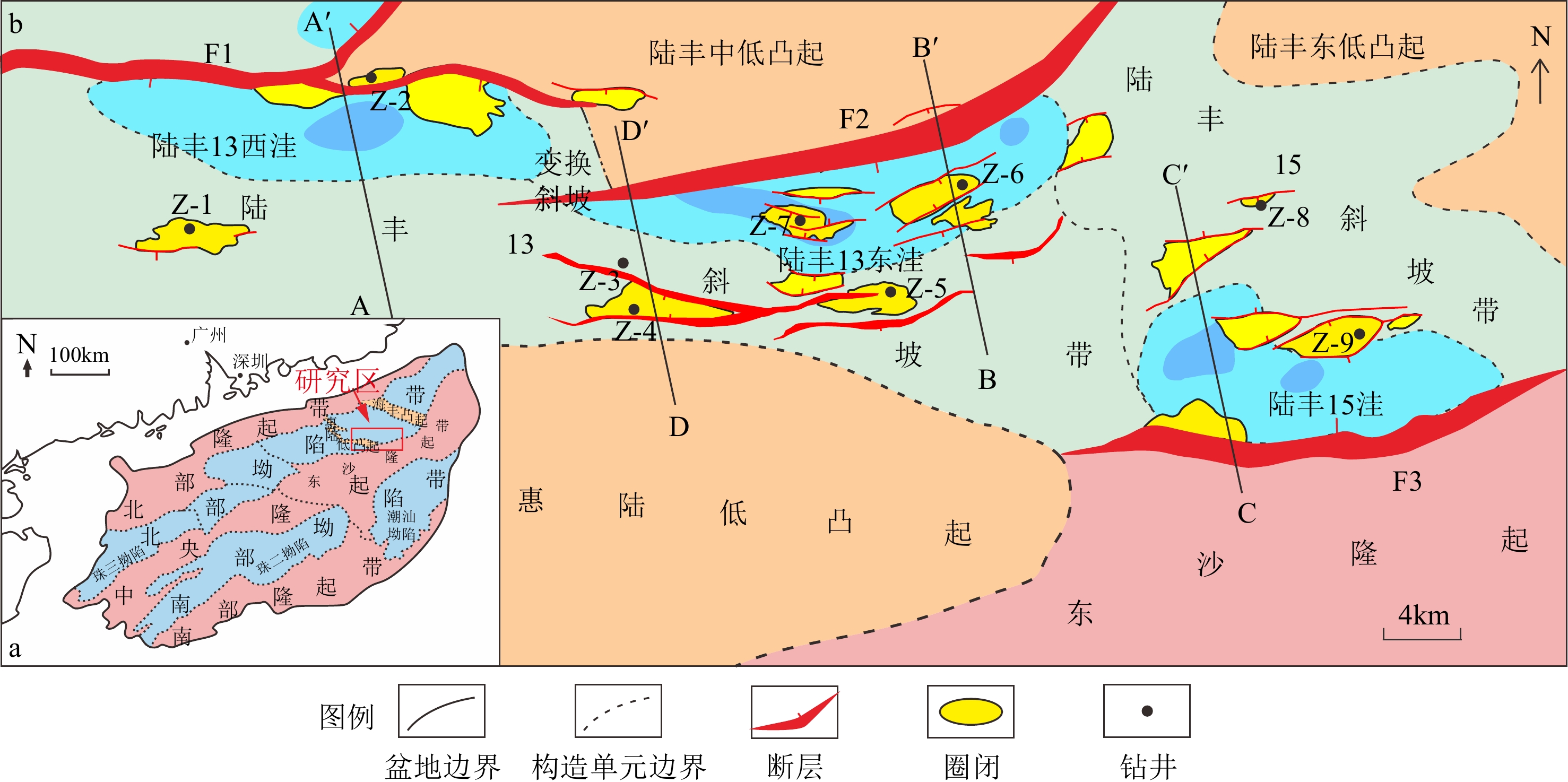
 下载:
下载:
